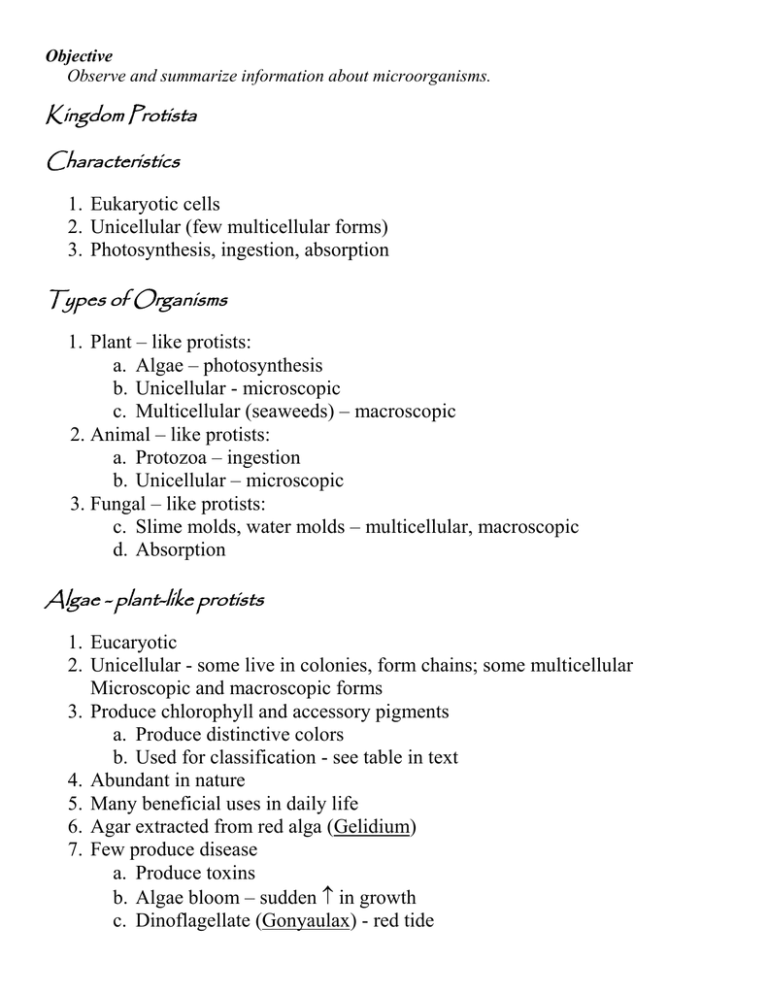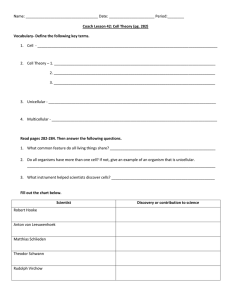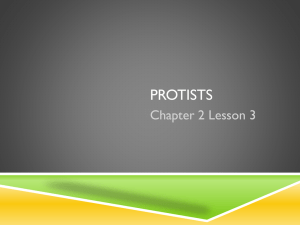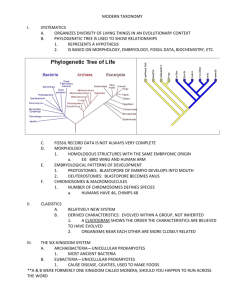Kingdom Protista Characteristics
advertisement

Objective Observe and summarize information about microorganisms. Kingdom Protista Characteristics 1. Eukaryotic cells 2. Unicellular (few multicellular forms) 3. Photosynthesis, ingestion, absorption Types of Organisms 1. Plant – like protists: a. Algae – photosynthesis b. Unicellular - microscopic c. Multicellular (seaweeds) – macroscopic 2. Animal – like protists: a. Protozoa – ingestion b. Unicellular – microscopic 3. Fungal – like protists: c. Slime molds, water molds – multicellular, macroscopic d. Absorption Algae - plant-like protists 1. Eucaryotic 2. Unicellular - some live in colonies, form chains; some multicellular Microscopic and macroscopic forms 3. Produce chlorophyll and accessory pigments a. Produce distinctive colors b. Used for classification - see table in text 4. Abundant in nature 5. Many beneficial uses in daily life 6. Agar extracted from red alga (Gelidium) 7. Few produce disease a. Produce toxins b. Algae bloom – sudden in growth c. Dinoflagellate (Gonyaulax) - red tide Objective Observe and summarize information about microorganisms. d. Secrete neurotoxin paralysis (paralytic shellfish poisoning) e. Neurotoxin consumed in raw, under-cooked shellfish (oysters); i. may also be inhaled in mists Protozoans – Animal-like Protists 1. 2. 3. 4. Eucaryotic Unicellular; some live in colonies Shape and size varies; distinctive Structurally more complex: a. No cell wall b. Pellicle - tough outer covering c. Cytosome - mouth opening, anal pore d. Cytoplasm - two layers i. Ectoplasm - outer layer, clear ii. Endoplasm - inner layer, granular 1 or 2 nuclei; organelles e. Food vacuoles, contractile vacuoles 5. Reproduce sexually or asexually 6. Some have complex life cycles involving several hosts: i. Definitive host - harbors adult, sexual stage ii. Intermediate - host harbors larvae, asexual stage 7. Trophozoite - vegetative form i. Cysts – encysted stage, dormant, survival, transmission 8. Ingest food from environment 9. Motile - pseudopodia, flagella, cilia 10. Classified according to method of motility : a. Sarcodina - amoebas Pseudopodia i. Outer cell membrane; some have outer shells ii. Engulf food particles by phagocytosis iii. Entamoeba histolytica - amoeba 1. Ingest cysts -parasitizes intestinal tract 2. Causes ulceration of intestinal mucosa amoebic dysentery b. Mastigophora i. Flagella, some have undulating membrane ii. Ingest food through cytosome Objective Observe and summarize information about microorganisms. iii. Giardia 1. Ingest cysts - parasitizes intestinal tract 2. Adheres to intestinal wall by means of adhesive disc - blocks absorption iv. Ciliata v. Cilia vi. Most complex of protozoans vii. Ingest food through cytosome food vacuoles viii. Eliminate waste anal pore ix. Macronucleus - metabolism x. Micronucleus - sexual reproduction xi. Balantidium coli 1. Ingest cysts - invades walls of large and small intestine ulceration 2. Causes dysentery similar to amoebic dysentery xii. Sporozoa 1. Non-motile 2. Obligate intracellular parasites 3. Complex life cycles, several intermediate stages, several hosts 4. Plasmodium 5. Malaria - parasitizes liver, rbc's 6. Transmitted by Anopheles mosquito xiii. Toxoplasma 1. Toxoplasmosis - parasitizes cells of lymph nodes 2. Transmion - inhaling dried feces of infected cat, ingested in under cooked meat 3. In pregnant females infects embryo, fetus 4. See life cycle – see text xiv. Cryptosporidium 1. Transmitted by feces of cows, dogs, cats, rodents 2. Ingested in drinking water - small intestine respiratory tract, gall bladder in AIDS patients)





